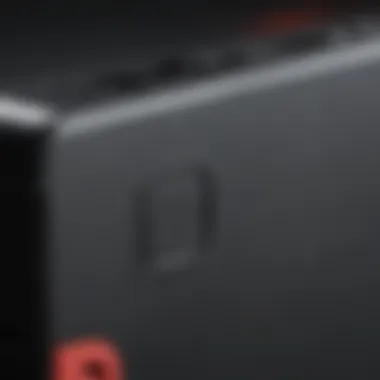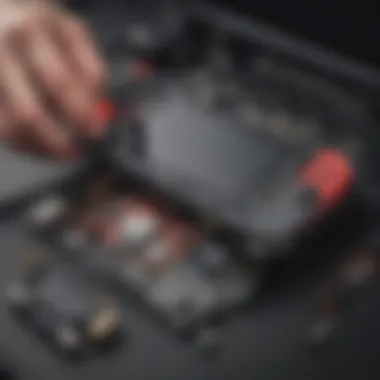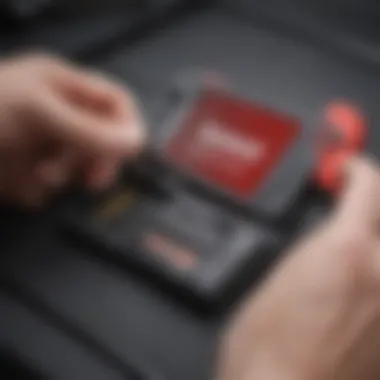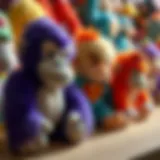Switch SD Card Reader Replacement: A Comprehensive Guide


Intro
The Nintendo Switch, celebrated for its versatility and engaging gameplay, occasionally encounters hardware limitations, particularly concerning its SD card reader. This component is critical for expanding storage and ensuring game data is accessible. Issues with the SD card reader can disrupt the gaming experience, leading to frustration. Therefore, understanding how to effectively replace this component is essential for both avid gamers and Nintendo fans.
Why Replacement is Necessary
SD card readers may fail for several reasons, including physical damage, wear and tear from frequent use, or even manufacturing defects. When the SD card reader malfunctions, users may experience problems like the console not recognizing the SD card or data loss. Recognizing these symptoms early can save time and prevent further damage.
Identifying the Issue
Before proceeding with a replacement, it is crucial to confirm that the SD card reader is indeed the problem. Common signs include:
- Inconsistent Recognition: The Switch often failing to detect the SD card.
- Error Messages: Notifications indicating that game data is not available or has been corrupted.
- Physical Damage: Visible signs of wear or damage to the SD card slot itself.
If these issues are apparent, it's time to consider a replacement. Understanding how to assess and address the problem empowers users to maintain their gaming setup effectively.
Step-by-Step Replacement Process
In this section, we will delve into the replacement process of the SD card reader, providing a detailed, step-by-step guide. Performing this task requires some tools and a methodical approach. Here’s a breakdown:
Tools Needed
- Small Phillips Head Screwdriver: Essential for removing screws from the console.
- Plastic Pry Tool: Useful for opening the console without damaging the casing.
- Tweezers: Handy for maneuvering small parts.
- Replacement SD Card Reader: Make sure the part is compatible with your Nintendo Switch model.
Step-by-Step Instructions
- Power Off the Console: Ensuring the device is completely powered down to avoid any electrical issues.
- Remove the Back Cover: Using the plastic pry tool, gently lift the back cover of the console without applying too much force.
- Locate the SD Card Reader: Identify the SD card reader, usually located on the motherboard. It may be obscured by other components.
- Unscrew the Reader: Carefully remove the screws securing the SD card reader to the motherboard. Keep track of where each screw goes.
- Disconnect the Reader: Gently disconnect the SD card reader from its connector. This may require some patience to avoid damaging nearby components.
- Insert the New Reader: Position the new SD card reader carefully. Ensure it aligns properly with the connector on the motherboard.
- Secure with Screws: Reattach all screws to hold the new reader in place firmly.
- Reattach the Back Cover: Finally, snap the back cover back onto the console, making sure it fits snugly.
- Power On the Device: Turn on your console and test the new SD card reader with a compatible card.
Troubleshooting Post-Installation
After replacement, some individuals may encounter new issues or lingering problems. Consider these tips:
- Test with Different SD Cards: Sometimes, the problem may lie with the card rather than the reader.
- Check Connections: Ensure that all connections are secure and undamaged.
- Consult Online Resources: Websites like Reddit have forums where users share experiences and solutions related to Nintendo Switch repairs.
"Taking the time for a careful replacement can significantly improve your gaming experience."
By following these steps, gamers can regain full functionality of their consoles without extensive downtime. Knowing how to manage hardware issues like SD card reader replacements enables enthusiasts to maximize their engagement with the Nintendo Switch.
Understanding the Importance of SD Card Readers in Nintendo Switch
The SD card reader in a Nintendo Switch is more than just a technical component. It serves as a vital interface that allows gamers to expand their storage capacity beyond the internal memory of the console. Understanding its importance is key to comprehending why issues with this component can significantly impact the gaming experience.
First, the SD card reader facilitates access to a larger library of games and downloadable content. As digital games continue to grow in size, having the ability to utilize a microSD card ensures that players do not face storage limitations. This is essential for gamers who wish to keep multiple games easily accessible, enhancing overall gameplay enjoyment.
Second, the performance of the SD card reader directly influences how smoothly games run. A fast and functioning SD card reader can lead to quicker load times, reducing instances of buffering or lag. This can be particularly noticeable in games that require frequent loading of textures or assets. Thus, the efficiency of this component contributes to a seamless gaming experience.
Moreover, the SD card reader's reliability is critical for data integrity. If the reader fails, it may result in corrupted data or loss of saved game progress. Therefore, maintaining a functional SD card reader is essential for safeguarding gamers' investments in both time and money.


In summary, the significance of the SD card reader in a Nintendo Switch extends beyond mere hardware; it enhances storage capacity, boosts performance, and ensures data safety. Addressing any issues with this component should be a priority for any serious gamer. Understanding these factors establishes a foundational knowledge needed for the subsequent sections that delves into troubleshooting and replacement.
Common Issues with SD Card Readers
Understanding the potential problems associated with SD card readers is crucial for any Nintendo Switch owner. Much like all electronic components, SD card readers are not immune to malfunctions. Recognizing these issues early can save time and prevent further complications down the line. This section outlines common problems gamers might face with their SD card readers and offers insights into identifying these concerns effectively.
Symptoms of a Faulty SD Card Reader
Identifying a faulty SD card reader starts with understanding the symptoms. Users often experience several telltale signs which should not be ignored.
- Inability to Read Games: One of the most common indications is when the Switch fails to recognize inserted SD cards. If you notice that your games are missing from the library or the console prompts you to insert a card when one is already present, this may be a clear sign of an issue.
- Frequent Errors: Errors often occur during gameplay if the card reader is faulty. You might find the console displaying messages about corrupted data or unexpectedly crashing. In such cases, files may be at risk of being lost entirely.
- Physical Damage: Inspecting the SD card slot visually can also reveal problems. Signs of wear, such as bent pins or debris within the slot, are serious indicators that the reader could be compromised.
If you encounter any of these symptoms, it may be time for a closer evaluation of the SD card reader's functionality.
Diagnostic Techniques to Identify Reader Problems
Diagnosing issues with an SD card reader requires a systematic approach. Here are some effective techniques you can use to identify the issues:
- Test with Different SD Cards: To rule out the possibility of a faulty SD card, try using different cards. If multiple cards fail to be recognized, the reader itself is likely at fault.
- Clean the Contacts: Sometimes dirt or dust can interfere with the connection. Gently cleaning both the SD card and the card slot with a can of compressed air may resolve the issue.
- Check the Console Software: Ensure your Nintendo Switch is up to date. Occasionally, software glitches can mimic hardware failures. A system update may rectify these problems.
- Conduct a System Reset: Performing a soft reset of the Nintendo Switch can sometimes resolve minor hiccups regarding SD card recognition. This method can refresh the internal software without affecting your data.
Knowing these diagnostic techniques can aid immensely in pinpointing the problem, saving you both time and frustration.
Remember: Early detection of SD card reader issues can prevent irreversible data loss.
Reasons for SD Card Reader Replacement
When considering the maintenance of a Nintendo Switch, the importance of the SD card reader cannot be overlooked. A well-functioning card reader ensures that players can access their games and save data without interruption. Over time, these components can face deterioration that affects performance. Addressing the need for SD card reader replacement involves understanding the factors that contribute to the degradation of the reader. This section will explore two notable reasons: wear and tear over time and the impact of environmental factors.
Wear and Tear Over Time
The life cycle of hardware components typically involves gradual decline due to prolonged use. Each time a game is saved, loaded, or updated, the SD card reader experiences some stress. As the years pass, internal connections may weaken, leading to inconsistent performance. This wear can manifest in various ways, such as failure to read the SD card, slow interaction with stored data, or frequent disconnections.
Investing in a replacement becomes vital when these symptoms become apparent. Not only does a functional SD card reader enhance gameplay, but it also prevents loss of saved information. Players may find themselves investing in new games, yet unable to access their libraries efficiently. Thus, when wear and tear become noticeable, undertaking a replacement is sensible for both enjoyment and utility.
Impact of Environmental Factors
Environmental elements also play a critical role in the longevity of the SD card reader. Factors such as dust, moisture, and extreme temperatures can significantly affect its functionality. Dust accumulation can disrupt connections, making it difficult for the console to register the SD card. This debris can also serve as an irritant, leading to additional mechanical stress when the user attempts to insert or remove the card.
Moisture, on the other hand, poses a serious risk. If the console is exposed to high humidity or spills, it can corrode the internal components, including the reader. Additionally, temperature extremes can influence the physical properties of the materials used in the reader, causing expansion or contraction that may lead to misalignment. To mitigate these risks, keeping the console in a clean, dry environment is essential.
Preparing for the Replacement Process
Replacing the SD card reader in a Nintendo Switch requires careful preparation. This phase determines how smoothly the entire process unfolds. When done correctly, it can save time and reduce the risk of further complications.
Preparing adequately means having the right tools and materials on hand. It also involves understanding the implications of the replacement process.
Tools Needed for Replacement
Before you start, ensure you have the right tools. Having the proper tools on hand is an essential step towards success in replacing the SD card reader. Missing tools can lead to frustration and potential damage to your console.


Some essential tools include:
- Small Phillips screwdriver: Necessary for unscrewing the console casing.
- Plastic opening tools: These help safely pry open the console without damaging the casing.
- Tweezers: Useful for precise handling of small components.
- Anti-static wrist strap: To prevent static electricity from damaging sensitive electronics.
Make sure your workspace is clean and free from clutter to avoid losing any small parts.
Gathering Necessary Materials
Apart from tools, gathering the right materials is crucial for a successful SD card reader replacement. Having everything at reach allows you to work continuously and minimizes interruptions, something that is highly beneficial during this process.
The primary material needed is, of course, the new SD card reader. Ensure that this replacement part is compatible with your specific Nintendo Switch model. Check:
- Model compatibility: Not all SD readers fit all Nintendo Switch versions. Double-check specifications to ensure a good match.
- Quality of the part: Opt for original equipment manufacturer (OEM) parts or well-reviewed aftermarket components to ensure reliability and longevity.
Furthermore, consider stocking extra screws and connectors just in case you lose any during the process. Dedicating time to this preparatory stage pays dividends, as having all necessary elements prepared means you can focus on the task, reducing the chance of error.
In summary, effective preparation is the cornerstone of a successful SD card reader replacement. With the right tools and materials in place, you set yourself up for a smoother and more efficient process.
Step-by-Step Guide to Replacing the SD Card Reader
Replacing the SD card reader in a Nintendo Switch is crucial for maintaining the device's functionality. When issues arise, they can disrupt gameplay and limit storage capacity. Thus, a clear guide is necessary to ensure gamers can navigate the replacement process confidently. This section provides specific steps to remove the old reader and install a new one effectively.
Powering Down the Nintendo Switch
Before any work begins, it is essential to power down the Nintendo Switch completely. This step protects both the user and the console. Ensuring the device is off reduces the risk of electrical shock and prevents potential damage to the hardware.
• To turn off the device, press and hold the power button for a few seconds. • Select "Power Options" from the menu that appears. • Choose "Turn Off" to complete the process completely.
Important: Do not proceed with the replacement if the console is still on or in sleep mode.
Opening the Console Safely
With the device powered down, the next step is to open the console. It is crucial to do this carefully to avoid damaging the casing or internal components.
- Gather a small, precision screwdriver set suitable for opening electronic devices.
- Use a plastic opening tool to gently pry open the back cover. Insert the tool into the seam and carefully work your way around the edges.
- Remove screws holding the cover in place. Remember to keep the screws organized for reassembly later.
Removing the Faulty SD Card Reader
Once the console is opened, focus on locating the faulty SD card reader.
• Identify the reader, which is generally located near the bottom of the console.
• Disconnect any attached cables gently. Use a precision tool to avoid damaging connectors.
• Remove screws that hold the SD card reader in place to extract it carefully. This step requires patience and a steady hand to avoid impacting related components.
Installing the New SD Card Reader
Now, install the new SD card reader into the console. Ensure compatibility with the Nintendo Switch for proper functionality. Follow these guidelines:
- Place the new reader in the same location as the old one. Check that it fits snugly.
- Reconnect any cables you previously detached, ensuring they are secured properly.
- Screw the new reader into place, taking care not to overtighten as it may damage the reader or board.
Reassembling the Console


After installing the new reader, the final task is to reassemble the console. This step is just as crucial as previous ones to maintain the device's integrity.
• First, replace the back cover by pressing it securely into place. • Reinsert all screws you removed earlier, ensuring they are tightened adequately, but again, avoid overtightening. • Finally, power on the Nintendo Switch to check if the new SD card reader is functioning correctly.
Following this guide will enable gamers to replace their SD card reader successfully, thereby reclaiming their gaming experience.
Post-Replacement Considerations
After successfully replacing the SD card reader in your Nintendo Switch, it is crucial to consider several post-replacement aspects. These considerations ensure the effective functioning of the new component and enhance the overall gaming experience. Taking time to evaluate these factors can prevent potential issues and maintain the health of your console.
Testing the New SD Card Reader
Testing the new SD card reader is essential. This step confirms that the installation is correct and the reader functions as expected. Here are some steps to follow for effective testing:
- Reconnect the Console: After reassembling your Nintendo Switch, power it on. Look for any initial error messages displayed during boot-up, which could indicate improper installation.
- Insert an SD Card: Use a known working SD card to check if the system recognizes it. Ensure the card is formatted correctly, preferably using the FAT32 filesystem for optimal performance with Nintendo Switch.
- Access Storage Menus: Navigate through the settings and check if the SD card is visible. If it appears under storage options, the reader is likely functioning properly.
- Test Game Loads: Launch a game stored on the SD card. If it loads without issues, this is a strong indication that the new reader works effectively.
Common Issues and Their Solutions
Even after careful installation, some issues may arise following the replacement of the SD card reader. It's pivotal to be aware of these potential pitfalls and know how to address them. Here are common problems along with their possible solutions:
- SD Card Not Recognized: This issue can occur due to improper connections or issues with the SD card itself. Reinsert the card, ensuring it fits snugly. If the problem persists, try a different card to rule out defects.
- System Freezes or Crashes: If your Switch becomes unresponsive during gameplay, this could point to an incompatible or faulty SD card. Consider updating your system software, as some newer cards may require the latest firmware.
- Corrupted Data: If you notice that data stored on the SD card is corrupted, it may warrant formatting the card. However, make sure to back up important files before proceeding to avoid data loss.
- Slow Performance: Sometimes, the performance may degrade after replacement. This can relate to the quality of the SD card or the reader. Using higher-end, fast-speed cards can mitigate this problem.
In summary, knowing how to troubleshoot these common issues empowers gamers to resolve problems quickly, facilitating uninterrupted gameplay and enjoyment.
Maintaining an SD Card Reader for Longevity
Maintaining an SD card reader in a Nintendo Switch is crucial for optimal performance and longevity. Many users overlook this aspect until problems arise. Regular maintenance can avoid the need for frequent replacements, which can be both costly and time-consuming. This section will outline best practices for care and usage, including how to prevent common issues and when to seek professional assistance.
Best Practices for Care and Use
Taking care of your SD card reader ensures that it remains functional over time. Here are some best practices to enhance its longevity:
- Handle with Care: Always insert and remove the SD card gently. Avoid using excessive force, as this can damage the reader itself.
- Keep It Clean: Dust and debris can accumulate, causing connectivity problems. Use a soft brush or compressed air to clean the slot periodically. Avoid using moist materials or chemicals.
- Choose Quality SD Cards: Not all SD cards are created equal. Invest in high-quality cards from reputable brands. They are often more durable and perform better with your device.
- Eject Properly: Always eject the SD card safely using the console’s menu before physically removing it. This helps prevent data corruption and extends the life of the card and reader.
- Monitor Usage: Be aware of how much data you are storing. Overloading the SD card can lead to issues. Keep sufficient free space to maintain optimal performance.
These practices are simple yet effective in prolonging the life of your SD card reader.
When to Seek Professional Help
Despite taking good care, issues may still arise. Knowing when to consult a professional can save time and prevent further damage. Here are some indicators:
- Persistent Errors: If you encounter repeated errors when reading from the SD card, it may indicate a deeper issue with the reader.
- Physical Damage: Any visible damage to the reader, such as cracks or bent connections, warrants professional assessment.
- Incompatibility Issues: If you recently started using a new SD card and the reader fails to recognize it, a professional can help determine if there is a compatibility issue at play.
- Internal Corruption: If the system frequently crashes or fails to load software stored on the card, it may be time to consult a technician.
Resources for Further Assistance
Navigating technical issues with gaming hardware, such as the Nintendo Switch SD card reader, can be challenging. It is essential to have access to reliable resources throughout the replacement process. These resources provide support, guidance, and community insight, which can be invaluable for both novice and experienced gamers. Knowing where to turn for assistance can save time, reduce frustration, and enhance overall gaming experiences.
Online Forums and Communities
Engaging with online forums and communities can significantly aid in your journey to resolve issues with your Nintendo Switch SD card reader. Websites like Reddit host dedicated threads where users share personal experiences related to hardware repairs. These platforms allow you to ask specific questions and receive answers from seasoned users who have gone through similar situations. Furthermore, communities created on platforms like Facebook provide a space for gamers to collaborate and exchange tips. By participating in these forums, you can gain access to various troubleshooting techniques, confirmation of concerns, and recommendations for which tools to utilize during the replacement process.
"Community input offers real-time solutions and experiences that facilitate a smoother repair process."
Manufacturer Support Options
In instances where community resources fall short, manufacturer support options serve as an important alternative. Nintendo offers customer support for hardware repairs, which includes guidance for replacing the SD card reader. Their official website provides detailed instructions on submitting your device for repair or obtaining replacement parts directly. Utilizing these channels ensures that you receive accurate and up-to-date information tailored specifically for your hardware. Additionally, manufacturer resources often include warranty options or repair services, potentially saving you expenses associated with self-repair endeavors.



